Analysis of Online Interaction for Personalized Learning in Google Doc
VerifiedAdded on 2021/09/19
|8
|1874
|78
Report
AI Summary
This report analyzes an online interaction within a Google Docs discussion forum, focusing on the extent of social and teacher presence in a personalized learning environment. The study utilizes the Community of Inquiry model, examining the interplay of social, teaching, and cognitive presence. The methodology involves coding text-based interactions to assess the prevalence of these elements. Findings reveal a higher consistency of social and teacher presence compared to cognitive presence. The report highlights the importance of emotional expression, open communication, and group cohesion. Recommendations include strategies to enhance cognitive presence, such as encouraging students to pose new ideas and connect concepts. The author plans to apply the Online Personalized Learning approach in their teaching, incorporating tools like YouTube and Google Chat. The report concludes that the Community of Inquiry model offers a valuable framework for analyzing and improving online learning experiences.
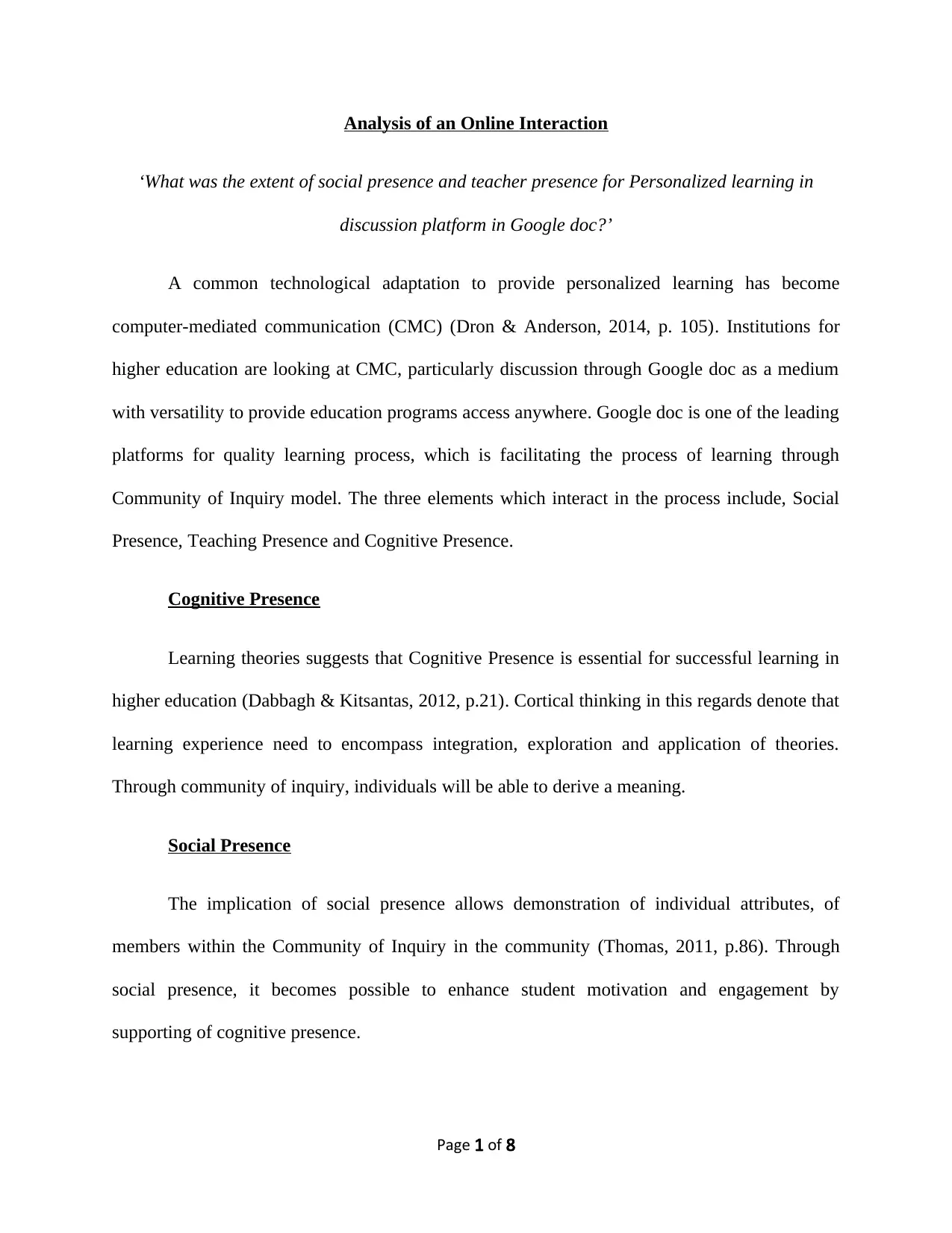
Analysis of an Online Interaction
‘What was the extent of social presence and teacher presence for Personalized learning in
discussion platform in Google doc?’
A common technological adaptation to provide personalized learning has become
computer-mediated communication (CMC) (Dron & Anderson, 2014, p. 105). Institutions for
higher education are looking at CMC, particularly discussion through Google doc as a medium
with versatility to provide education programs access anywhere. Google doc is one of the leading
platforms for quality learning process, which is facilitating the process of learning through
Community of Inquiry model. The three elements which interact in the process include, Social
Presence, Teaching Presence and Cognitive Presence.
Cognitive Presence
Learning theories suggests that Cognitive Presence is essential for successful learning in
higher education (Dabbagh & Kitsantas, 2012, p.21). Cortical thinking in this regards denote that
learning experience need to encompass integration, exploration and application of theories.
Through community of inquiry, individuals will be able to derive a meaning.
Social Presence
The implication of social presence allows demonstration of individual attributes, of
members within the Community of Inquiry in the community (Thomas, 2011, p.86). Through
social presence, it becomes possible to enhance student motivation and engagement by
supporting of cognitive presence.
Page 1 of 8
‘What was the extent of social presence and teacher presence for Personalized learning in
discussion platform in Google doc?’
A common technological adaptation to provide personalized learning has become
computer-mediated communication (CMC) (Dron & Anderson, 2014, p. 105). Institutions for
higher education are looking at CMC, particularly discussion through Google doc as a medium
with versatility to provide education programs access anywhere. Google doc is one of the leading
platforms for quality learning process, which is facilitating the process of learning through
Community of Inquiry model. The three elements which interact in the process include, Social
Presence, Teaching Presence and Cognitive Presence.
Cognitive Presence
Learning theories suggests that Cognitive Presence is essential for successful learning in
higher education (Dabbagh & Kitsantas, 2012, p.21). Cortical thinking in this regards denote that
learning experience need to encompass integration, exploration and application of theories.
Through community of inquiry, individuals will be able to derive a meaning.
Social Presence
The implication of social presence allows demonstration of individual attributes, of
members within the Community of Inquiry in the community (Thomas, 2011, p.86). Through
social presence, it becomes possible to enhance student motivation and engagement by
supporting of cognitive presence.
Page 1 of 8
Paraphrase This Document
Need a fresh take? Get an instant paraphrase of this document with our AI Paraphraser
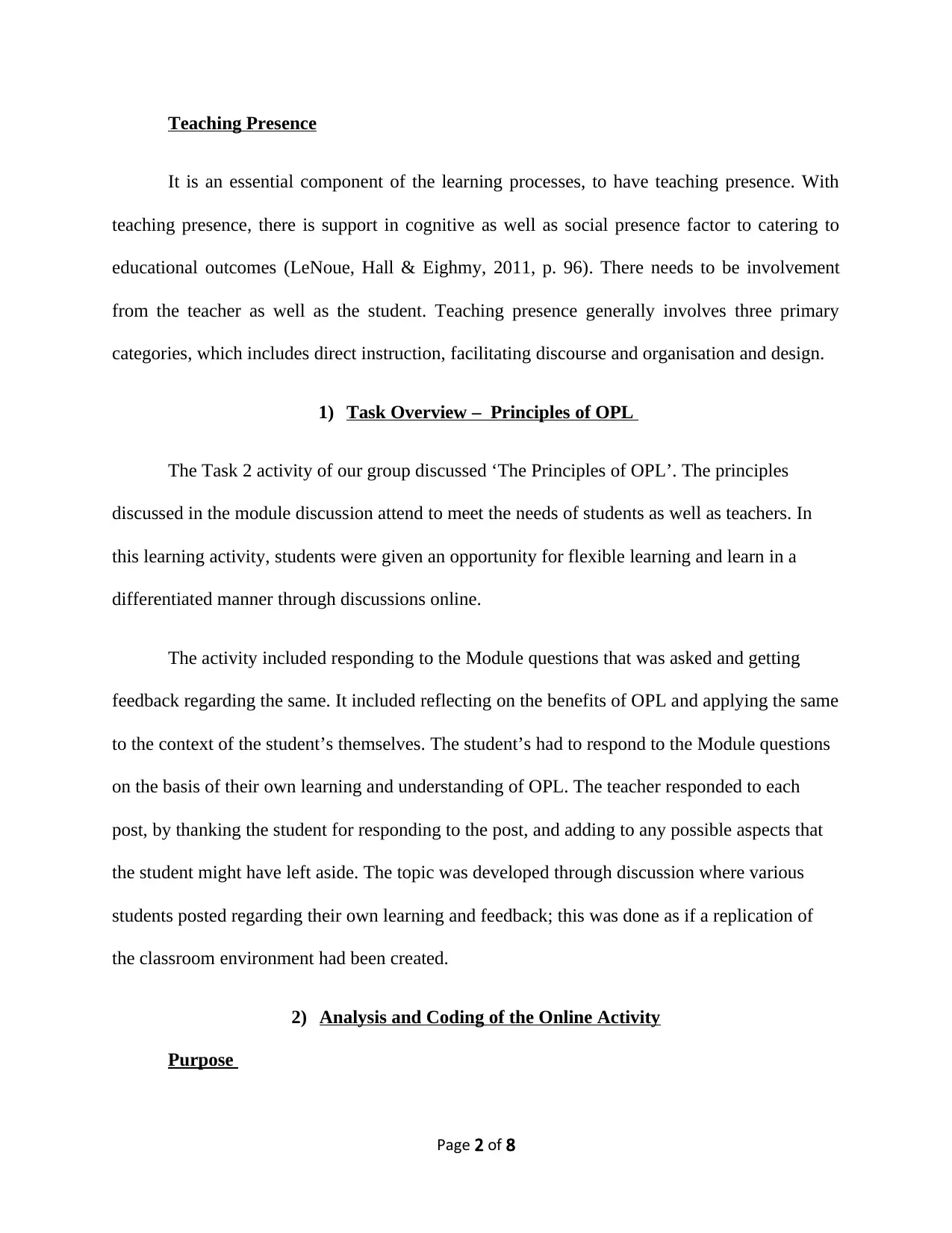
Teaching Presence
It is an essential component of the learning processes, to have teaching presence. With
teaching presence, there is support in cognitive as well as social presence factor to catering to
educational outcomes (LeNoue, Hall & Eighmy, 2011, p. 96). There needs to be involvement
from the teacher as well as the student. Teaching presence generally involves three primary
categories, which includes direct instruction, facilitating discourse and organisation and design.
1) Task Overview – Principles of OPL
The Task 2 activity of our group discussed ‘The Principles of OPL’. The principles
discussed in the module discussion attend to meet the needs of students as well as teachers. In
this learning activity, students were given an opportunity for flexible learning and learn in a
differentiated manner through discussions online.
The activity included responding to the Module questions that was asked and getting
feedback regarding the same. It included reflecting on the benefits of OPL and applying the same
to the context of the student’s themselves. The student’s had to respond to the Module questions
on the basis of their own learning and understanding of OPL. The teacher responded to each
post, by thanking the student for responding to the post, and adding to any possible aspects that
the student might have left aside. The topic was developed through discussion where various
students posted regarding their own learning and feedback; this was done as if a replication of
the classroom environment had been created.
2) Analysis and Coding of the Online Activity
Purpose
Page 2 of 8
It is an essential component of the learning processes, to have teaching presence. With
teaching presence, there is support in cognitive as well as social presence factor to catering to
educational outcomes (LeNoue, Hall & Eighmy, 2011, p. 96). There needs to be involvement
from the teacher as well as the student. Teaching presence generally involves three primary
categories, which includes direct instruction, facilitating discourse and organisation and design.
1) Task Overview – Principles of OPL
The Task 2 activity of our group discussed ‘The Principles of OPL’. The principles
discussed in the module discussion attend to meet the needs of students as well as teachers. In
this learning activity, students were given an opportunity for flexible learning and learn in a
differentiated manner through discussions online.
The activity included responding to the Module questions that was asked and getting
feedback regarding the same. It included reflecting on the benefits of OPL and applying the same
to the context of the student’s themselves. The student’s had to respond to the Module questions
on the basis of their own learning and understanding of OPL. The teacher responded to each
post, by thanking the student for responding to the post, and adding to any possible aspects that
the student might have left aside. The topic was developed through discussion where various
students posted regarding their own learning and feedback; this was done as if a replication of
the classroom environment had been created.
2) Analysis and Coding of the Online Activity
Purpose
Page 2 of 8
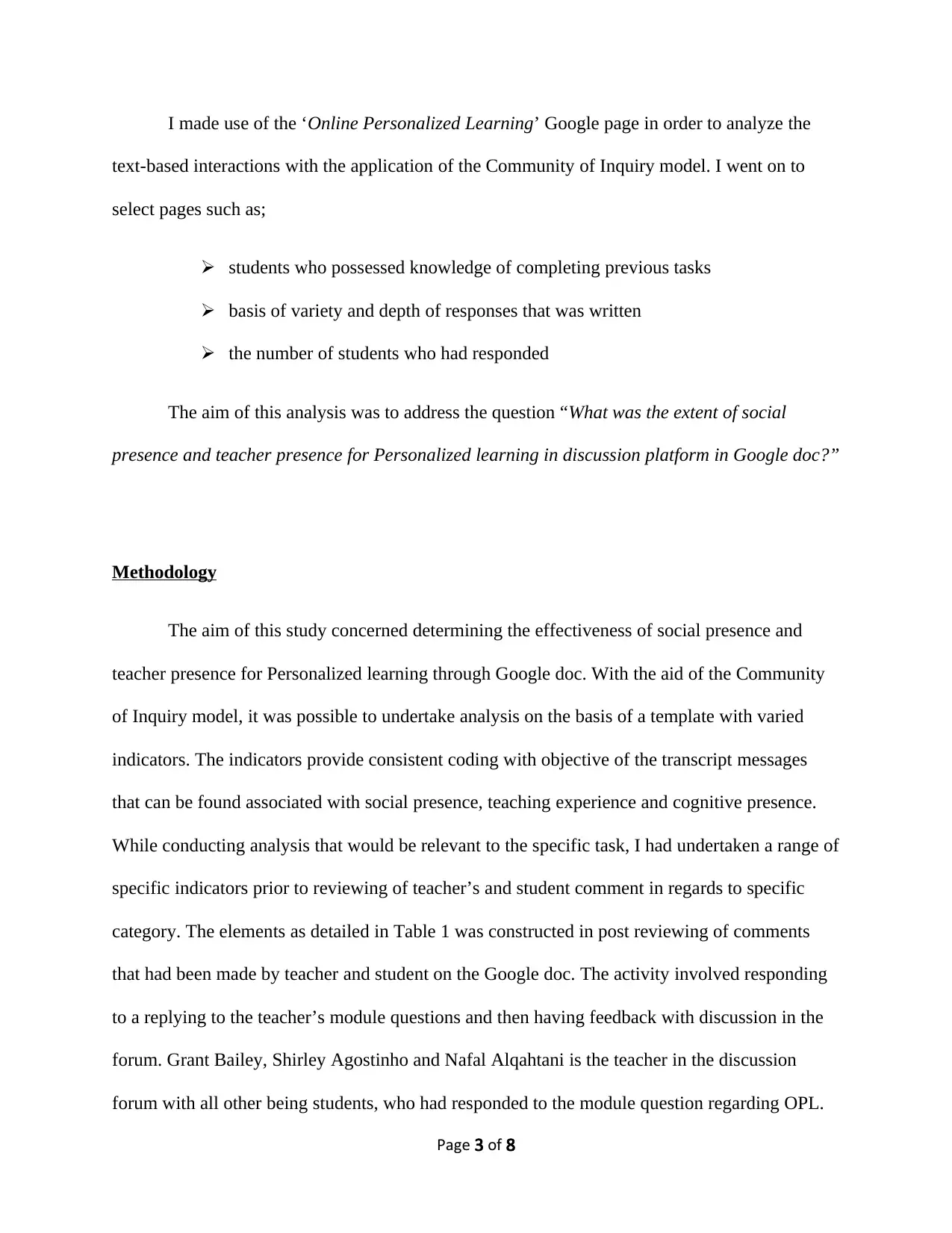
I made use of the ‘Online Personalized Learning’ Google page in order to analyze the
text-based interactions with the application of the Community of Inquiry model. I went on to
select pages such as;
students who possessed knowledge of completing previous tasks
basis of variety and depth of responses that was written
the number of students who had responded
The aim of this analysis was to address the question “What was the extent of social
presence and teacher presence for Personalized learning in discussion platform in Google doc?”
Methodology
The aim of this study concerned determining the effectiveness of social presence and
teacher presence for Personalized learning through Google doc. With the aid of the Community
of Inquiry model, it was possible to undertake analysis on the basis of a template with varied
indicators. The indicators provide consistent coding with objective of the transcript messages
that can be found associated with social presence, teaching experience and cognitive presence.
While conducting analysis that would be relevant to the specific task, I had undertaken a range of
specific indicators prior to reviewing of teacher’s and student comment in regards to specific
category. The elements as detailed in Table 1 was constructed in post reviewing of comments
that had been made by teacher and student on the Google doc. The activity involved responding
to a replying to the teacher’s module questions and then having feedback with discussion in the
forum. Grant Bailey, Shirley Agostinho and Nafal Alqahtani is the teacher in the discussion
forum with all other being students, who had responded to the module question regarding OPL.
Page 3 of 8
text-based interactions with the application of the Community of Inquiry model. I went on to
select pages such as;
students who possessed knowledge of completing previous tasks
basis of variety and depth of responses that was written
the number of students who had responded
The aim of this analysis was to address the question “What was the extent of social
presence and teacher presence for Personalized learning in discussion platform in Google doc?”
Methodology
The aim of this study concerned determining the effectiveness of social presence and
teacher presence for Personalized learning through Google doc. With the aid of the Community
of Inquiry model, it was possible to undertake analysis on the basis of a template with varied
indicators. The indicators provide consistent coding with objective of the transcript messages
that can be found associated with social presence, teaching experience and cognitive presence.
While conducting analysis that would be relevant to the specific task, I had undertaken a range of
specific indicators prior to reviewing of teacher’s and student comment in regards to specific
category. The elements as detailed in Table 1 was constructed in post reviewing of comments
that had been made by teacher and student on the Google doc. The activity involved responding
to a replying to the teacher’s module questions and then having feedback with discussion in the
forum. Grant Bailey, Shirley Agostinho and Nafal Alqahtani is the teacher in the discussion
forum with all other being students, who had responded to the module question regarding OPL.
Page 3 of 8
⊘ This is a preview!⊘
Do you want full access?
Subscribe today to unlock all pages.

Trusted by 1+ million students worldwide
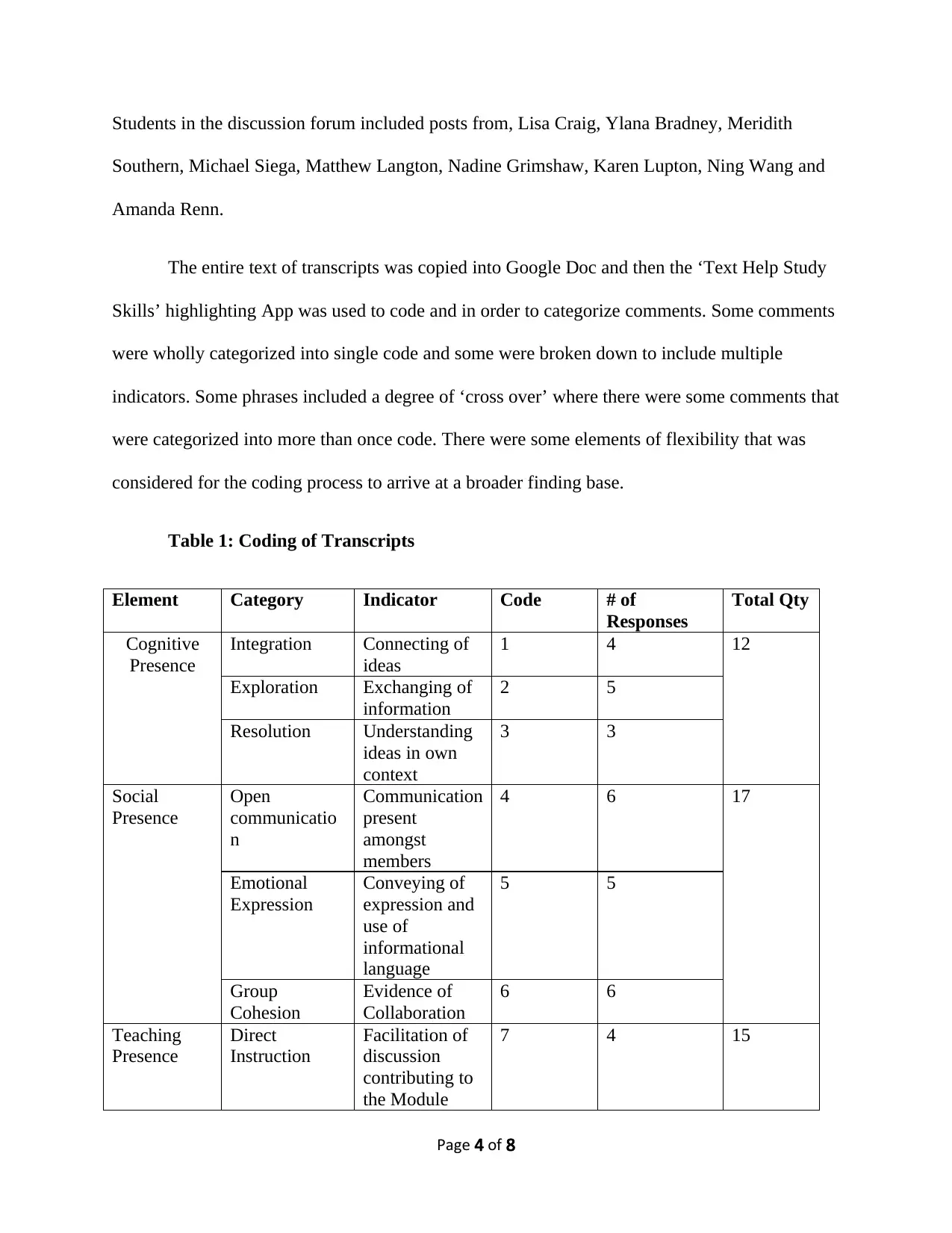
Students in the discussion forum included posts from, Lisa Craig, Ylana Bradney, Meridith
Southern, Michael Siega, Matthew Langton, Nadine Grimshaw, Karen Lupton, Ning Wang and
Amanda Renn.
The entire text of transcripts was copied into Google Doc and then the ‘Text Help Study
Skills’ highlighting App was used to code and in order to categorize comments. Some comments
were wholly categorized into single code and some were broken down to include multiple
indicators. Some phrases included a degree of ‘cross over’ where there were some comments that
were categorized into more than once code. There were some elements of flexibility that was
considered for the coding process to arrive at a broader finding base.
Table 1: Coding of Transcripts
Element Category Indicator Code # of
Responses
Total Qty
Cognitive
Presence
Integration Connecting of
ideas
1 4 12
Exploration Exchanging of
information
2 5
Resolution Understanding
ideas in own
context
3 3
Social
Presence
Open
communicatio
n
Communication
present
amongst
members
4 6 17
Emotional
Expression
Conveying of
expression and
use of
informational
language
5 5
Group
Cohesion
Evidence of
Collaboration
6 6
Teaching
Presence
Direct
Instruction
Facilitation of
discussion
contributing to
the Module
7 4 15
Page 4 of 8
Southern, Michael Siega, Matthew Langton, Nadine Grimshaw, Karen Lupton, Ning Wang and
Amanda Renn.
The entire text of transcripts was copied into Google Doc and then the ‘Text Help Study
Skills’ highlighting App was used to code and in order to categorize comments. Some comments
were wholly categorized into single code and some were broken down to include multiple
indicators. Some phrases included a degree of ‘cross over’ where there were some comments that
were categorized into more than once code. There were some elements of flexibility that was
considered for the coding process to arrive at a broader finding base.
Table 1: Coding of Transcripts
Element Category Indicator Code # of
Responses
Total Qty
Cognitive
Presence
Integration Connecting of
ideas
1 4 12
Exploration Exchanging of
information
2 5
Resolution Understanding
ideas in own
context
3 3
Social
Presence
Open
communicatio
n
Communication
present
amongst
members
4 6 17
Emotional
Expression
Conveying of
expression and
use of
informational
language
5 5
Group
Cohesion
Evidence of
Collaboration
6 6
Teaching
Presence
Direct
Instruction
Facilitation of
discussion
contributing to
the Module
7 4 15
Page 4 of 8
Paraphrase This Document
Need a fresh take? Get an instant paraphrase of this document with our AI Paraphraser
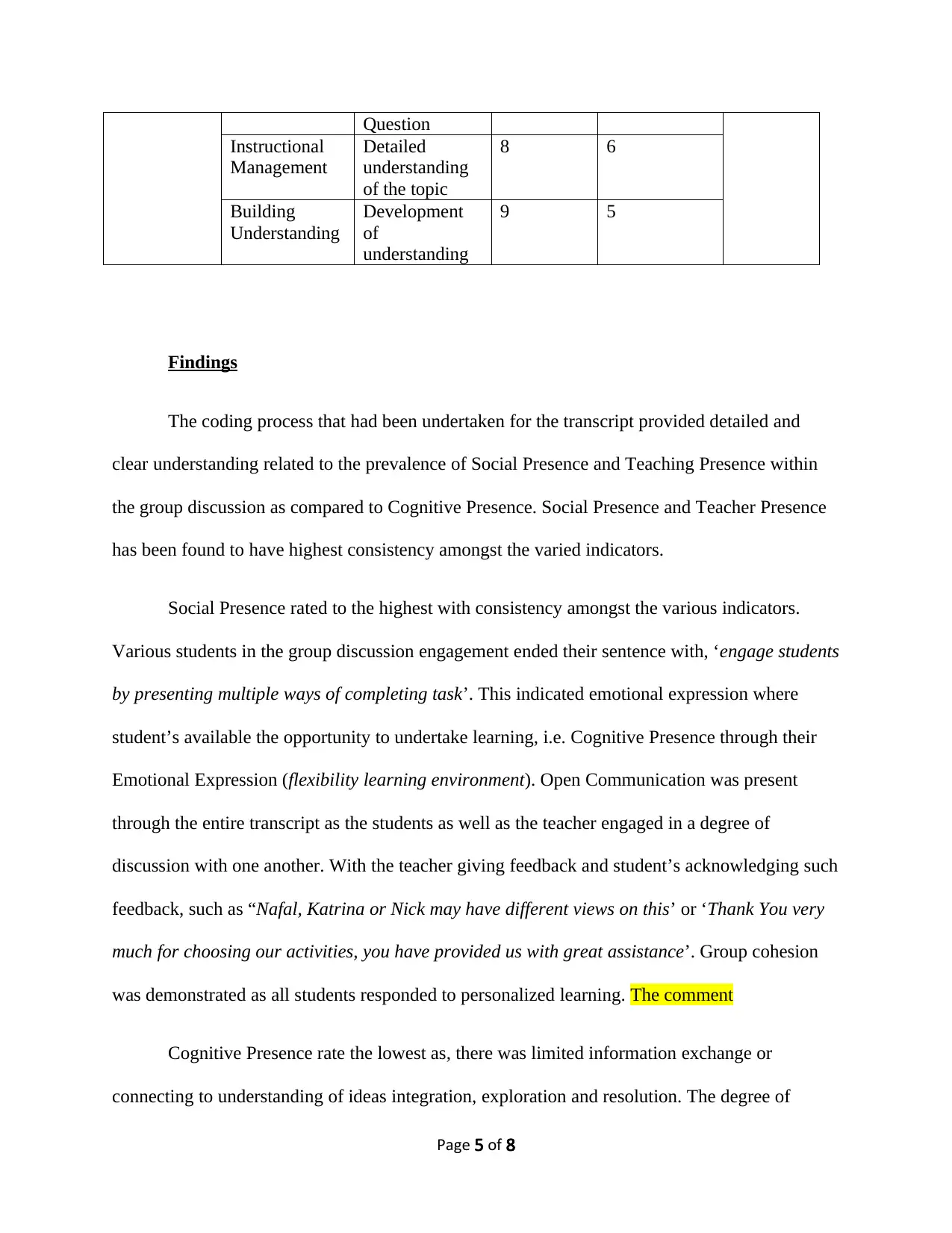
Question
Instructional
Management
Detailed
understanding
of the topic
8 6
Building
Understanding
Development
of
understanding
9 5
Findings
The coding process that had been undertaken for the transcript provided detailed and
clear understanding related to the prevalence of Social Presence and Teaching Presence within
the group discussion as compared to Cognitive Presence. Social Presence and Teacher Presence
has been found to have highest consistency amongst the varied indicators.
Social Presence rated to the highest with consistency amongst the various indicators.
Various students in the group discussion engagement ended their sentence with, ‘engage students
by presenting multiple ways of completing task’. This indicated emotional expression where
student’s available the opportunity to undertake learning, i.e. Cognitive Presence through their
Emotional Expression (flexibility learning environment). Open Communication was present
through the entire transcript as the students as well as the teacher engaged in a degree of
discussion with one another. With the teacher giving feedback and student’s acknowledging such
feedback, such as “Nafal, Katrina or Nick may have different views on this’ or ‘Thank You very
much for choosing our activities, you have provided us with great assistance’. Group cohesion
was demonstrated as all students responded to personalized learning. The comment
Cognitive Presence rate the lowest as, there was limited information exchange or
connecting to understanding of ideas integration, exploration and resolution. The degree of
Page 5 of 8
Instructional
Management
Detailed
understanding
of the topic
8 6
Building
Understanding
Development
of
understanding
9 5
Findings
The coding process that had been undertaken for the transcript provided detailed and
clear understanding related to the prevalence of Social Presence and Teaching Presence within
the group discussion as compared to Cognitive Presence. Social Presence and Teacher Presence
has been found to have highest consistency amongst the varied indicators.
Social Presence rated to the highest with consistency amongst the various indicators.
Various students in the group discussion engagement ended their sentence with, ‘engage students
by presenting multiple ways of completing task’. This indicated emotional expression where
student’s available the opportunity to undertake learning, i.e. Cognitive Presence through their
Emotional Expression (flexibility learning environment). Open Communication was present
through the entire transcript as the students as well as the teacher engaged in a degree of
discussion with one another. With the teacher giving feedback and student’s acknowledging such
feedback, such as “Nafal, Katrina or Nick may have different views on this’ or ‘Thank You very
much for choosing our activities, you have provided us with great assistance’. Group cohesion
was demonstrated as all students responded to personalized learning. The comment
Cognitive Presence rate the lowest as, there was limited information exchange or
connecting to understanding of ideas integration, exploration and resolution. The degree of
Page 5 of 8
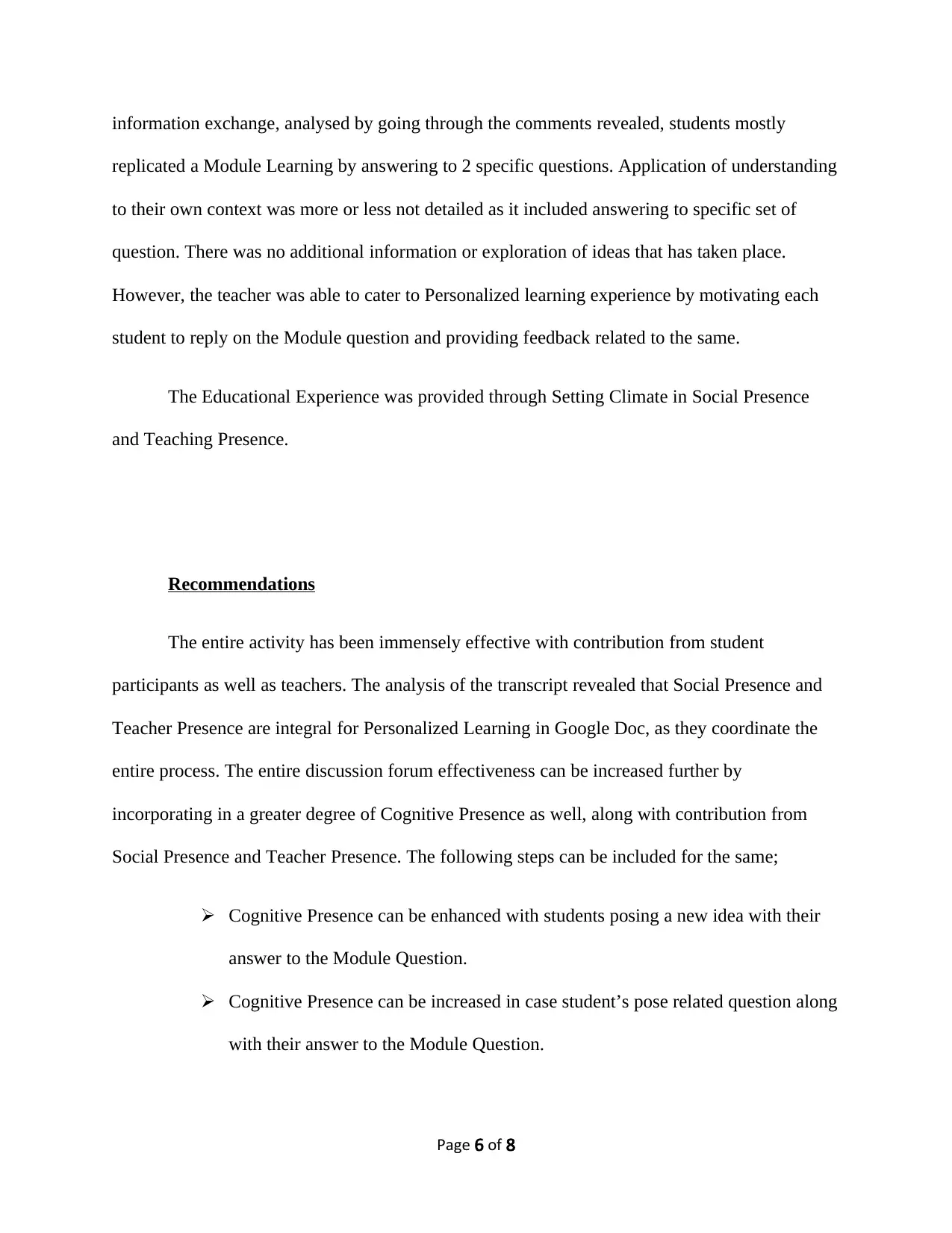
information exchange, analysed by going through the comments revealed, students mostly
replicated a Module Learning by answering to 2 specific questions. Application of understanding
to their own context was more or less not detailed as it included answering to specific set of
question. There was no additional information or exploration of ideas that has taken place.
However, the teacher was able to cater to Personalized learning experience by motivating each
student to reply on the Module question and providing feedback related to the same.
The Educational Experience was provided through Setting Climate in Social Presence
and Teaching Presence.
Recommendations
The entire activity has been immensely effective with contribution from student
participants as well as teachers. The analysis of the transcript revealed that Social Presence and
Teacher Presence are integral for Personalized Learning in Google Doc, as they coordinate the
entire process. The entire discussion forum effectiveness can be increased further by
incorporating in a greater degree of Cognitive Presence as well, along with contribution from
Social Presence and Teacher Presence. The following steps can be included for the same;
Cognitive Presence can be enhanced with students posing a new idea with their
answer to the Module Question.
Cognitive Presence can be increased in case student’s pose related question along
with their answer to the Module Question.
Page 6 of 8
replicated a Module Learning by answering to 2 specific questions. Application of understanding
to their own context was more or less not detailed as it included answering to specific set of
question. There was no additional information or exploration of ideas that has taken place.
However, the teacher was able to cater to Personalized learning experience by motivating each
student to reply on the Module question and providing feedback related to the same.
The Educational Experience was provided through Setting Climate in Social Presence
and Teaching Presence.
Recommendations
The entire activity has been immensely effective with contribution from student
participants as well as teachers. The analysis of the transcript revealed that Social Presence and
Teacher Presence are integral for Personalized Learning in Google Doc, as they coordinate the
entire process. The entire discussion forum effectiveness can be increased further by
incorporating in a greater degree of Cognitive Presence as well, along with contribution from
Social Presence and Teacher Presence. The following steps can be included for the same;
Cognitive Presence can be enhanced with students posing a new idea with their
answer to the Module Question.
Cognitive Presence can be increased in case student’s pose related question along
with their answer to the Module Question.
Page 6 of 8
⊘ This is a preview!⊘
Do you want full access?
Subscribe today to unlock all pages.

Trusted by 1+ million students worldwide
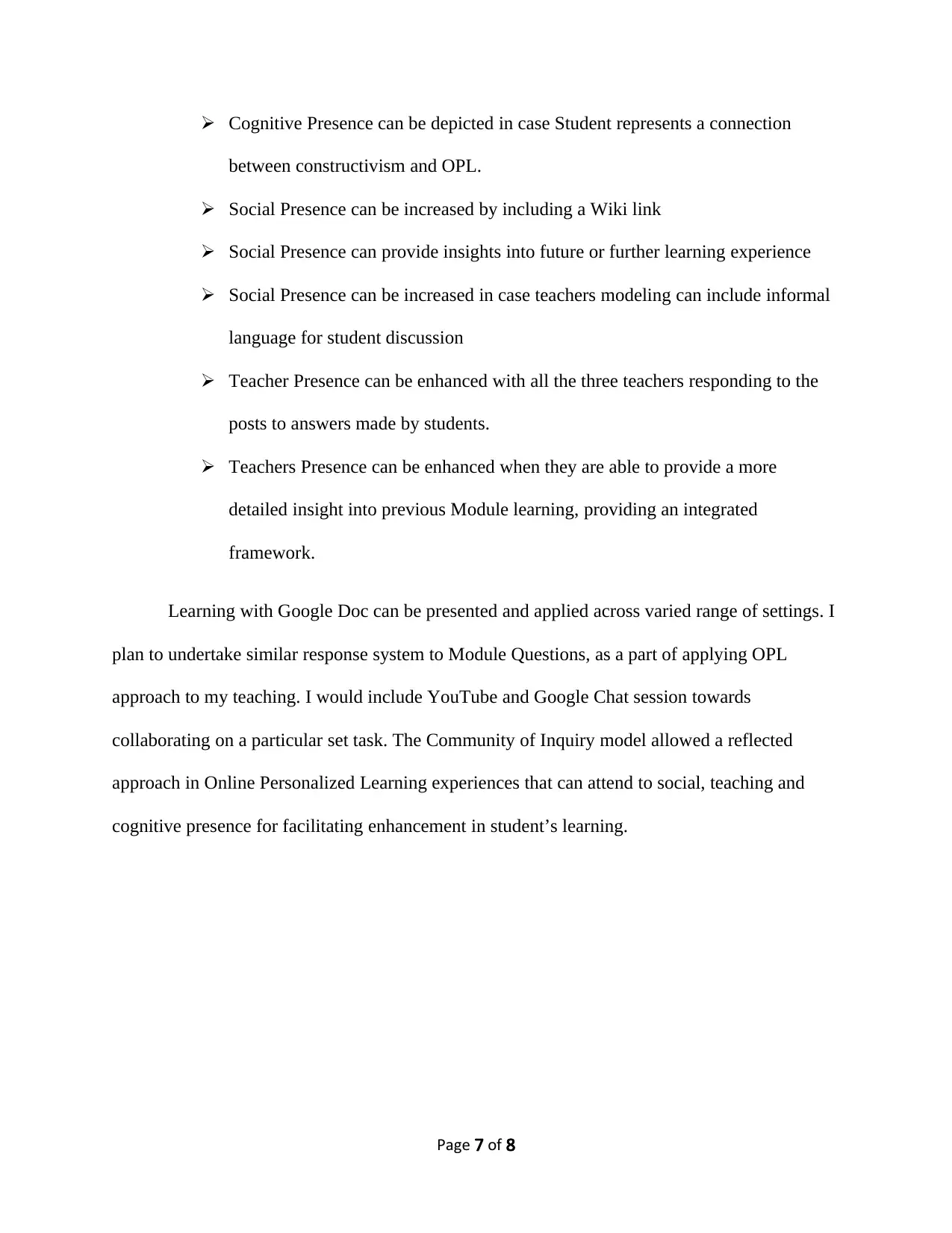
Cognitive Presence can be depicted in case Student represents a connection
between constructivism and OPL.
Social Presence can be increased by including a Wiki link
Social Presence can provide insights into future or further learning experience
Social Presence can be increased in case teachers modeling can include informal
language for student discussion
Teacher Presence can be enhanced with all the three teachers responding to the
posts to answers made by students.
Teachers Presence can be enhanced when they are able to provide a more
detailed insight into previous Module learning, providing an integrated
framework.
Learning with Google Doc can be presented and applied across varied range of settings. I
plan to undertake similar response system to Module Questions, as a part of applying OPL
approach to my teaching. I would include YouTube and Google Chat session towards
collaborating on a particular set task. The Community of Inquiry model allowed a reflected
approach in Online Personalized Learning experiences that can attend to social, teaching and
cognitive presence for facilitating enhancement in student’s learning.
Page 7 of 8
between constructivism and OPL.
Social Presence can be increased by including a Wiki link
Social Presence can provide insights into future or further learning experience
Social Presence can be increased in case teachers modeling can include informal
language for student discussion
Teacher Presence can be enhanced with all the three teachers responding to the
posts to answers made by students.
Teachers Presence can be enhanced when they are able to provide a more
detailed insight into previous Module learning, providing an integrated
framework.
Learning with Google Doc can be presented and applied across varied range of settings. I
plan to undertake similar response system to Module Questions, as a part of applying OPL
approach to my teaching. I would include YouTube and Google Chat session towards
collaborating on a particular set task. The Community of Inquiry model allowed a reflected
approach in Online Personalized Learning experiences that can attend to social, teaching and
cognitive presence for facilitating enhancement in student’s learning.
Page 7 of 8
Paraphrase This Document
Need a fresh take? Get an instant paraphrase of this document with our AI Paraphraser
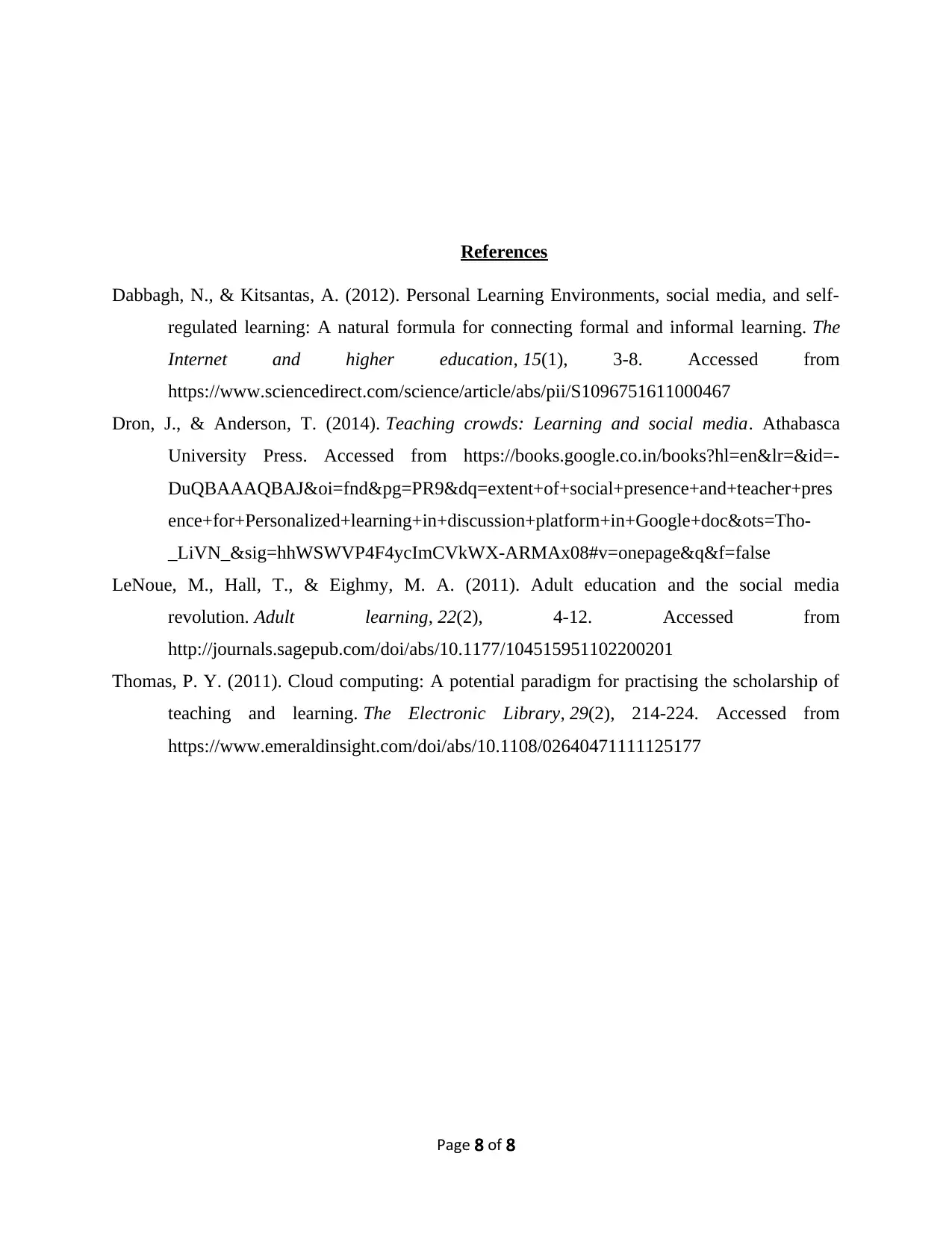
References
Dabbagh, N., & Kitsantas, A. (2012). Personal Learning Environments, social media, and self-
regulated learning: A natural formula for connecting formal and informal learning. The
Internet and higher education, 15(1), 3-8. Accessed from
https://www.sciencedirect.com/science/article/abs/pii/S1096751611000467
Dron, J., & Anderson, T. (2014). Teaching crowds: Learning and social media. Athabasca
University Press. Accessed from https://books.google.co.in/books?hl=en&lr=&id=-
DuQBAAAQBAJ&oi=fnd&pg=PR9&dq=extent+of+social+presence+and+teacher+pres
ence+for+Personalized+learning+in+discussion+platform+in+Google+doc&ots=Tho-
_LiVN_&sig=hhWSWVP4F4ycImCVkWX-ARMAx08#v=onepage&q&f=false
LeNoue, M., Hall, T., & Eighmy, M. A. (2011). Adult education and the social media
revolution. Adult learning, 22(2), 4-12. Accessed from
http://journals.sagepub.com/doi/abs/10.1177/104515951102200201
Thomas, P. Y. (2011). Cloud computing: A potential paradigm for practising the scholarship of
teaching and learning. The Electronic Library, 29(2), 214-224. Accessed from
https://www.emeraldinsight.com/doi/abs/10.1108/02640471111125177
Page 8 of 8
Dabbagh, N., & Kitsantas, A. (2012). Personal Learning Environments, social media, and self-
regulated learning: A natural formula for connecting formal and informal learning. The
Internet and higher education, 15(1), 3-8. Accessed from
https://www.sciencedirect.com/science/article/abs/pii/S1096751611000467
Dron, J., & Anderson, T. (2014). Teaching crowds: Learning and social media. Athabasca
University Press. Accessed from https://books.google.co.in/books?hl=en&lr=&id=-
DuQBAAAQBAJ&oi=fnd&pg=PR9&dq=extent+of+social+presence+and+teacher+pres
ence+for+Personalized+learning+in+discussion+platform+in+Google+doc&ots=Tho-
_LiVN_&sig=hhWSWVP4F4ycImCVkWX-ARMAx08#v=onepage&q&f=false
LeNoue, M., Hall, T., & Eighmy, M. A. (2011). Adult education and the social media
revolution. Adult learning, 22(2), 4-12. Accessed from
http://journals.sagepub.com/doi/abs/10.1177/104515951102200201
Thomas, P. Y. (2011). Cloud computing: A potential paradigm for practising the scholarship of
teaching and learning. The Electronic Library, 29(2), 214-224. Accessed from
https://www.emeraldinsight.com/doi/abs/10.1108/02640471111125177
Page 8 of 8
1 out of 8
Related Documents
Your All-in-One AI-Powered Toolkit for Academic Success.
+13062052269
info@desklib.com
Available 24*7 on WhatsApp / Email
![[object Object]](/_next/static/media/star-bottom.7253800d.svg)
Unlock your academic potential
Copyright © 2020–2025 A2Z Services. All Rights Reserved. Developed and managed by ZUCOL.




